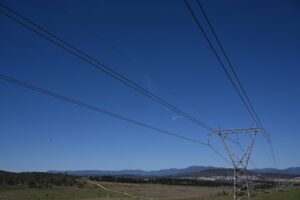 Former Duke Energy CEO Jim Rogers predicts that nearly every single power plant operating today — aside from some hydro and perhaps a few nuclear plants — will be replaced by the middle of the century. He called it a “blank sheet of paper” that opens up the possibility of a major transformation for utilities.
Former Duke Energy CEO Jim Rogers predicts that nearly every single power plant operating today — aside from some hydro and perhaps a few nuclear plants — will be replaced by the middle of the century. He called it a “blank sheet of paper” that opens up the possibility of a major transformation for utilities.
Speaking at a recent Brookings Institution event on the future of utilities, Rogers offered his candid take on where the power business is headed. Although centralized natural gas and nuclear are at the top of his list for low-carbon technologies, Rogers said he believed a more distributed grid is inevitable.
“If you believe that climate is a problem — and I do — one of the big challenges as we redesign the generation fleet in this country is what will this mix will be,” said Rogers. “Utilities need to embrace the future. They need to embrace distributed generation.”
Before leaving his position as CEO last July, Rogers was blunt about the need to strengthen Duke’s promotion of rooftop solar. The utility has already procured 400 megawatts of solar PV projects, but only 50 megawatts of that is rooftop solar. In 2009, Duke started a 10-megawatt rooftop solar program in North Carolina; however, Rogers called for legislative changes in the state to allow its renewables development arm to compete directly in the market with solar installers.
“This is a business we want to invest in — we want to earn off of it. We don’t want to cede it to others,” he told the Charlotte Business Journal two months before stepping down as chief executive.
Since Rogers’ departure, Duke has shifted its stance and asked regulators to lower current net metering payments for residential solar from 11 cents per kilowatt-hour to 7 cents per kilowatt-hour. Like other utilities, Duke is worried that solar system owners will shift the cost of maintaining the grid to other customers.
“I think it’s an important issue for Duke. […] We’re supportive of the technology, we think it fits in the portfolio, but we think it should be fair,” said current Duke CEO Lynn Good in an interview with reporters.
The Alliance for Solar Choice (TASC), a solar advocacy organization focused on state net metering battles, jumped on Good’s comments. In an open letter to Rogers (who is still chairman of Duke’s board), TASC co-chairs Bryan Miller and John Stanton lamented the utility’s position on solar crediting policies.
“Unfortunately, your successor Lynn Good lacks your vision. Just last week she met with local reporters and attacked rooftop solar to defend Duke’s monopoly,” wrote Miller and Stanton. “You are uniquely positioned to help Duke and its trade association see a better way forward. Help them realize that rent-seeking from regulators to protect their monopolies, instead of adapting to serve the needs of today’s energy consumers, is a short-sighted and deeply flawed strategy.”
As yet, no definitive assessment of solar’s cost and benefit to the grid has emerged, and the debate rages on over how to properly incentivize the technology as its economics improve and utilities face a surge of installations.
Rather than blame utilities for these conflicts, however, Rogers said state regulators are a big part of the problem. He called for “de-coupling on steroids” to give power companies more incentive to procure a wider range of resources.
Rogers has been outspoken about North Carolina law, which prevents utility subsidiaries from doing business with the owning company. That has hindered Duke’s ability to invest in rooftop solar projects, he said. But he believes that regulators need to go further and develop a system where utilities get compensated for the quality of services they provide as a “system integrator.”
“We haven’t had the capability to deal with distributed generation,” said Rogers. “We have to have a regulatory model built to accelerate our role as a battery, as an optimizer.”
Although Rogers wasn’t specific on exactly what that regulatory construct might look like, his idea mirrors the RIIO model (revenue = incentives + innovation + outputs) used in the U.K. That model sets a broad range of policy outcomes — such as environmental performance, power quality, efficiency and higher amounts of distributed generation — and compensates utilities based on their ability to achieve them.
Former Colorado Public Utilities Commissioner Ron Lehr recently described the approach as part of the project called America’s Power Plan: “The business skills to accomplish these tasks would be analogous to the conductor’s role in orchestral music. In this analogy, policymakers in both government and corporations choose the music for the orchestra’s season, playing the music director’s role.”
After 25 years as a utility CEO, Rogers has finally moved on. But as chairman of Duke’s board and a member of the executive committee at the Edison Electric Institute, he still has influence in the industry. At a time when the power sector is publicly debating the impact of “disruptive challenges,” part of Rogers’ legacy may hinge on whether his influence helps utilities and regulators adapt.
“The reality is that this sweep of technology is huge,” said Rogers. “Will the utility industry be equipped to handle all this?”








